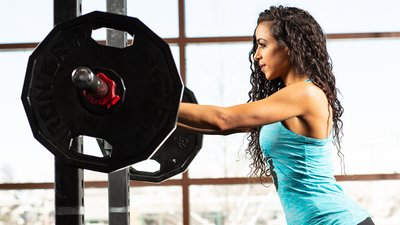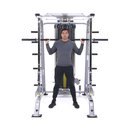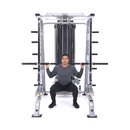The glutes are a surprisingly fickle muscle group. Often, you feel like you're working them, but you're only working part of them—and not even that hard!
Think about those classic butt-builders like squats, deadlifts, step-ups, and lunges. Sure, they all hit the gluteus maximus, but the truth is that the quads and hamstrings usually "butt in" on these movements and hog most of the muscle activation. Even the increasingly popular hip thrust can use as much quad as butt!
So here's the deal: In order to really challenge the glutes and force them to become more than just a backseat driver, your workout needs to include a mix of movements that come at this giant muscle group from multiple angles. You need strength work that hits every part of your lower body, followed by isolation work to hammer the neglected glute muscles with a crazy pump.
Lucky for you, four-time IFBB Figure Olympia champion Nicole Wilkins has exactly the workout you need. It's an all-around lower-body burner that will run your booty through the fire and forge it into something hotter and stronger than ever. Here's what you need to know to build the booty of your dreams.
Warm Muscles Are Strong Muscles
During a time crunch, many people opt to skip the warm-up phase of their workouts. If you're just coming in for some quick arms and abs, that may cut it. But when you're gearing up for a tough lower-body battle like this one, you simply must warm up first.
This is exercise phys 101, people: Warmer muscles are more efficient muscles. They're more resilient muscles. They're stronger muscles. Case closed!
"Try a five-minute warm-up on the treadmill, followed by 2-3 warm-up sets for the first exercise of the workout," recommends Wilkins. If you need more, do it. Just find a way to heat up your engine.
The Clock Is a Glute's Best Friend
Not everyone can handle as much volume as Wilkins, so dial back the workload as necessary. If you structure your workout right, you can still give your lower body the same level of muscular stimulation.
How? Simple: Pay attention to your rest periods by watching the clock. "This workout is intense, so be sure to keep moving," says Wilkins. "Your rest periods after each superset should be about 30-45 seconds—no longer."
You can use the clock in the gym, your phone, or even click an old-school stopwatch, but use something. Stay strict!
Slow and Controlled Wins the Glute Race
Just because your rest periods feel rushed doesn't mean your sets should. Slow down the lowering portions of movements like squats and lunges, even if it means you have to dial back the weight. The alternative is crashing into the bottom, putting your back and knees at risk—particularly if you're trying to lift more than you should.
"Form is number one," states Wilkins. "You want to focus on doing slow and controlled movements at all times to ensure optimal results—never rush through the movement." To be clear: Yes, it'll burn like crazy, but that's all part of the plan.
"When performing lunges and squats, you want to go slightly lower than parallel to fully engage the glutes," says Wilkins. Don't rob yourself of maximum results because you cheated on the full range of motion. That's when your quads will sneak in and steal your glutes' rightful gains!
Move Horizontally, Not Just Vertically
Most of the strength and muscle-building work we do in the gym is performed in what's known as the sagittal plane. What this means is that it's an up-and-down motion, rather than a lateral (frontal plane) or rotational (transverse plane) motion. Think about it: Squats, lunges, bench presses, pull-ups, pull-downs, arm work, leg raises—all of it is sagittal. With the glutes, this simply isn't going to cut it.
Sure, those squats, step-ups, and lunges will make you sore, but they're primarily using only one of the three glute muscles, the gluteus maximus. The other two—the gluteus medius and minimus—are primarily used to pull your legs away from the midline of your body. This is why movements like band lateral walks and curtsy lunges are essential. But if you're only used to working your butt the old way, expect to be sore!
The 42-Set Glute Salute
This lower-body workout hits the hamstring as well as the glutes, but it gives extra attention to the glutes in particular. Most of the movements come in supersets, which means you should perform the two movements back to back to count as one set. After you're done, Wilkins advises you take a few minutes to stretch post-workout while your muscles are still warm.
The workout can be performed up to 2-3 times a week, but you can dial back the volume if necessary. That may sound like a lot, but it could be just what you need. If you're used to simply doing leg and hamstring work and trusting that you're hitting your glutes, try this for a few weeks and prepare to be shocked!

BodyFit
$6.99/month- 2,500+ expert-created single workouts
- 3,500+ how-to exercise videos
- Detailed workout instruction
- Step-by-step workout tips
- Training at gym or at home
- Access to Workout Plans
- Access to Bodyfit App
- Store Discounts
Already have a Bodybuilding.com account with BodyFit? Sign In

What comes with BodyFit?

- Instructional Videos
Don't risk doing a workout improperly! Avoid injury and keep your form in check with in-depth instructional videos.

- How-to Images
View our enormous library of workout photos and see exactly how each exercise should be done before you give it a shot.

- Step-by-Step Instructions
Quickly read through our step-by-step directions to ensure you're doing each workout correctly the first time, every time.




